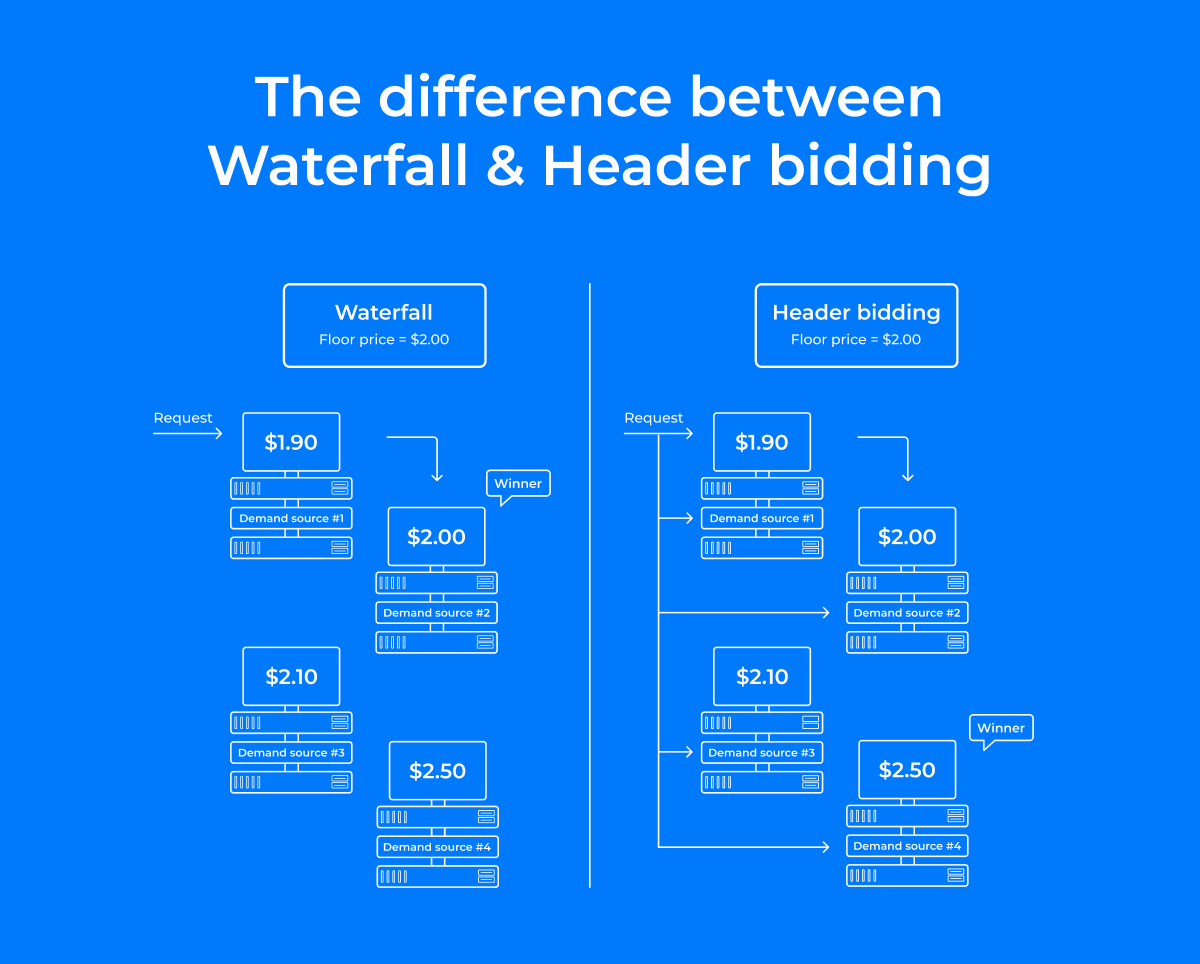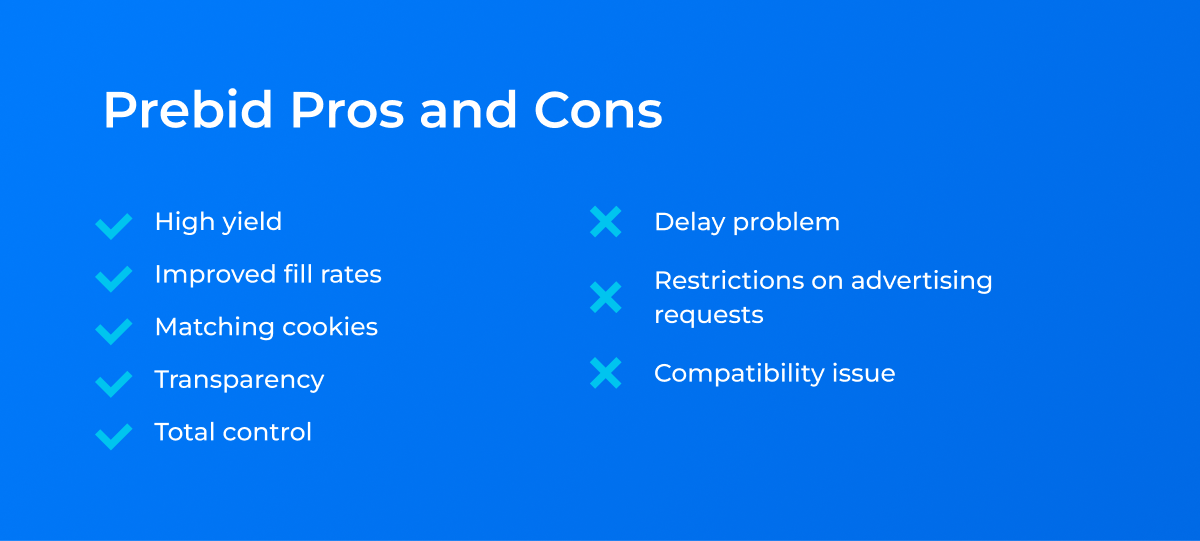Significantly improving the efficiency of advertising ecosystems is a dream of almost every digital publisher. It’s great when the commercial space embedded in a website generates the maximum financial benefit by displaying ads.
One of the best tools to achieve this goal is header bidding. Header bidding is also called advance bidding or pre-bidding. It provides an excellent opportunity to showcase ad inventory to multiple demand partners, and competition can help boost ad revenue.
Table of Contents
What is Header Bidding?
It is important to note that this is a modern alternative to the old-fashioned waterfall method. Header bidding is an advanced ad-serving technique that helps publishers to offer their inventory to several advertising networks, DSPs, or exchanges simultaneously instead of the step-by-step waterfall method. Rate requests are sent to several partners, taking into account the demand.
Header bidding ensures that the publisher’s inventory is simultaneously available to all advertisers wanting to buy it. And the winner is determined by fair bidding. This technology provides the publisher with the maximum income Using the auction of the first or second price.
Embedding code snippets (JavaScript) in a site’s head section allows publishers to generate a bid request using browser resources. The auction is triggered primarily through the header section of the page. Afterward, bids are filtered according to unique criteria, which allows showing the most profitable ad on the user’s screen.
History of Header Bidding&Prebid
Initially, there was almost no alternative to the waterfall method in the world of digital advertising.
Let’s imagine we have traveled back to the 2000-s using a time machine. What will we see if we take a closer look at the process of ad trades?
In the realm of ad tech, publishers (also referred to as the “supply side”) curate a roster of eligible advertisers (comprising the “demand side”) who can bid on available ad space, commonly known as ad inventory. Subsequently, this inventory is auctioned off in a step-by-step ‘waterfall’ order, with each partner passing it on to the next until it’s finally sold. However, the chain-like process can result in high latency due to the possibility of partners passing on the inventory. Additionally, the initial advertiser in the chain who places a bid may not necessarily yield the highest revenue for the publisher. Efficiency and profit from this technique must be considered low. Toward the late 2000-s, significant changes ripened that led to the emergence of Header Bidding.
Back in 2009, header bidding technology debuted, but it wasn’t without flaws. The early stages of header bidding were riddled with problems, such as the absence of industry standards, a lack of cooperation among providers, and incomplete solutions.
However, in 2015, Prebid.js made its entrance onto the scene, and everything changed. A new and more efficient way to approach ad trades has come in sight! Despite the presence of competitors, this tool increased its Ad Tech industry expansion thanks to several factors:
- it is a free tool that anyone can use;
- technology flexibility;
- can be used on PC, smartphones, laptops, and tablets;
- available in different formats (video, displays, native);
- excellent technical support;
- technology provides rapid growth;
- many additional functions and opportunities for analytics of the tool.
What Makes Header Bidding Different
Now you are acquainted with pre-bidding, it will be natural to compare this technology with the waterfall method in a more detailed way. After all, it is one of the most actively used algorithms.

The technology aims to help all publishers increase their advertising revenue in both cases. Some of them seem similar or even identical. But the waterfall method has a severe drawback. It is the linearity of the trading system used. Due to this, the technology is noticeably inferior to the more modern pre-bidding.
It’s easy to explain. For example, when using waterfall technology, the winner is the first bidder to bid above the specified minimum. But there needs to be more opportunity to get the highest price possible.
But there is an alternative – it’s pre-bidding. Since bids are made simultaneously, the one who offers the highest bid is chosen as the winner. It brings significant benefits to the publisher.
Role of Prebid.js
Header bidding reduced delays and increased revenue via website advertising. But as we mentioned, this web technology could have been better at the early stages.
During industry chaos, Prebid.js stepped in to bring order by establishing a dependable and effortless standard, resulting in the widespread adoption of pre-bidding technology worldwide. Over 66% of publishers currently leverage pre-bidding to attain optimal eCPM while keeping latency to a minimum.
How Prebid.js Works?
Pre-bidding is used to simplify and facilitate the conduct of simultaneous bidding from several partners at once. It allows advertising publishers to get the maximum financial benefit. But only some fully understand how this happens.
If you don’t use the prebid wrapper, the ad tag query will run every time the user visits the site. But if you wrap the web page title, the ad request will be held until real-time bids come in from competing DSPs.
It just takes a few easy steps to complete the whole pre-bid auction:
- Prebid.js retrieves bids and creatives from ad exchanges and SSPs in response to an impression becoming available on a website.
- Prebid.js sends ads and bids directly to ad servers;
- The ad server scrutinizes bids submitted within the timeframe set by the publisher, considering various factors such as ad format, floor price, and ad type.;
- If there is a winning bet, data about it is transferred from the server to the Prebid.js module, where it is displayed.
Prebid Pros and Cons
Let’s start with the benefits of this technology.

- High yield. You need not rely on previous data to set a minimum price. The technology allows you to see in advance the potential profit from advertising. The one who makes the highest bid wins;
- Improved fill rates. Profitability and occupancy are growing at the same time. Every offer is noticed. Header bidding eliminates the risk of padding;
- Matching cookies. The whole process takes place via the browser. Due to this, the DSP and SSP can synchronize cookies;
- Publisher gains transparency and total control of the entire trading process.
But there are also disadvantages to the method.
- Delay problem. The new procedure is designed to improve the inefficiency of the waterfall method, but it could be better. Due to a large number of scripts added to the header, the load time increases. It can degrade the user experience;
- Restrictions on advertising requests. The browser has limits on the number of requests per turn. Therefore, the betting shell also receives restrictions. Hence the limits on the number of on-demand partners able to bid;
- Compatibility issue. Not all browsers have good interoperability with this technology.
Key Takeaways
Header bidding is an advanced ad-serving software technology that enables publishers to offer their inventory to multiple advertising networks or exchanges simultaneously, unlike the step-by-step waterfall method.
Our tech staff and AdOps are formed by the best AdTech and MarTech industry specialists with 10+ years of proven track record!

According to recent statistics, over 80% of top websites in the United States and approximately 50% of publishers in the country can generate more significant revenue per 1,000 ad impressions using header bidding.
Although header bidding emerged in 2009, it had several limitations.
However, Prebid.js was introduced in 2015 and successfully organized the previously chaotic industry by establishing a reliable and user-friendly standard. This development led to the widespread adoption of pre-bidding technology worldwide.
The benefits of this innovative technology include higher yield for publishers, improved fill rate, increased transparency, and the ability for publishers to control the bidding process.
Are you a publisher looking to maximize your revenue? If so, Prebid technology is the answer you’ve been searching for. With Prebid, publishers can increase their income and take their business to the next level.
Request a free demo of BidsCube SSP and discover the power of Header Bidding or Header Bidding&oRTB combination.

